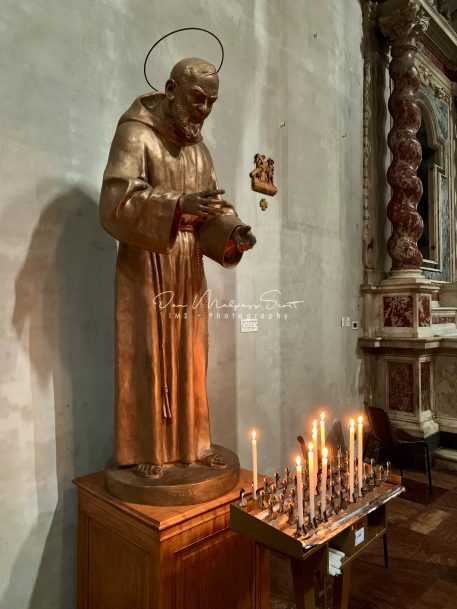![]()
Statue of Pio of Pietrelcina in San Michele in Borgo, Pisa, Italy
Pio of Pietrelcina (born Francesco Forgione; 25 May 1887 – 23 September 1968), widely known as Padre Pio (Italian for ‘Father Pius’), was an Italian Capuchin friar, priest, stigmatist, and mystic. He is venerated as a saint in the Catholic Church, celebrated on 23 September.
Pio joined the Capuchins at fifteen and spent most of his religious life in the convent of San Giovanni Rotondo. He was marked by stigmata in 1918, leading to several investigations by the Holy See. Despite temporary sanctions imposed by the Vatican, his reputation kept increasing during his life, attracting many followers to San Giovanni Rotondo. He was the founder of the Casa Sollievo della Sofferenza, a hospital built near the convent of San Giovanni Rotondo.
After his death, his devotion continued to spread among believers all over the world. He was beatified on 2 May 1999 and canonized on 16 June 2002 by Pope John Paul II. His relics are exposed in the sanctuary of Saint Pio of Pietrelcina, next to the convent of San Giovanni Rotondo, now a major pilgrimage site.
San Michele in Borgo is a Roman Catholic church in Pisa, region of Tuscany, Italy.
The church, together with monastery (which first belonged to the Benedictines, and, from the 12th century, the Camaldolese) was built in the late 10th to early 11th century outside the walls of the city, over an ancient temple dedicated to Mars. Both were restored several times in the following ages.
The façade is from the 14th century. The upper part has three order of typically Pisane Gothic loggias. There are three portals, also in Gothic style and withlunettes; the main one is surmounted by a tabernacle with “Madonna and Child” by Lupo di Francesco (the original is in the National Museum of San Matteo in Pisa).
The solemn interior, with a nave and two aisles, houses a Crucifix attributed to Nino Pisano (14th century), paintings by Matteo Rosselli, Baccio Lomi, Aurelio Lomi and Giuseppe Melani, as well as remains of frescoes from the 13th century. Under the pavement is the crypt, probably what remains of a former church.
![]()


